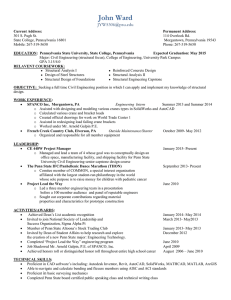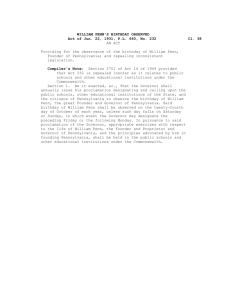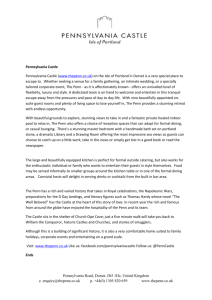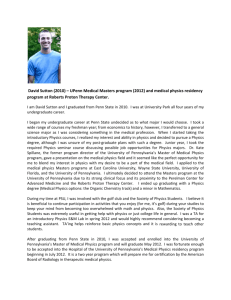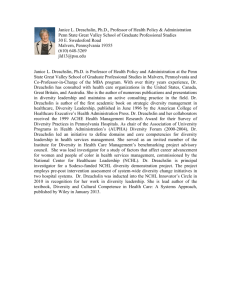Penn State's 2016-17 Appropriation Request
advertisement
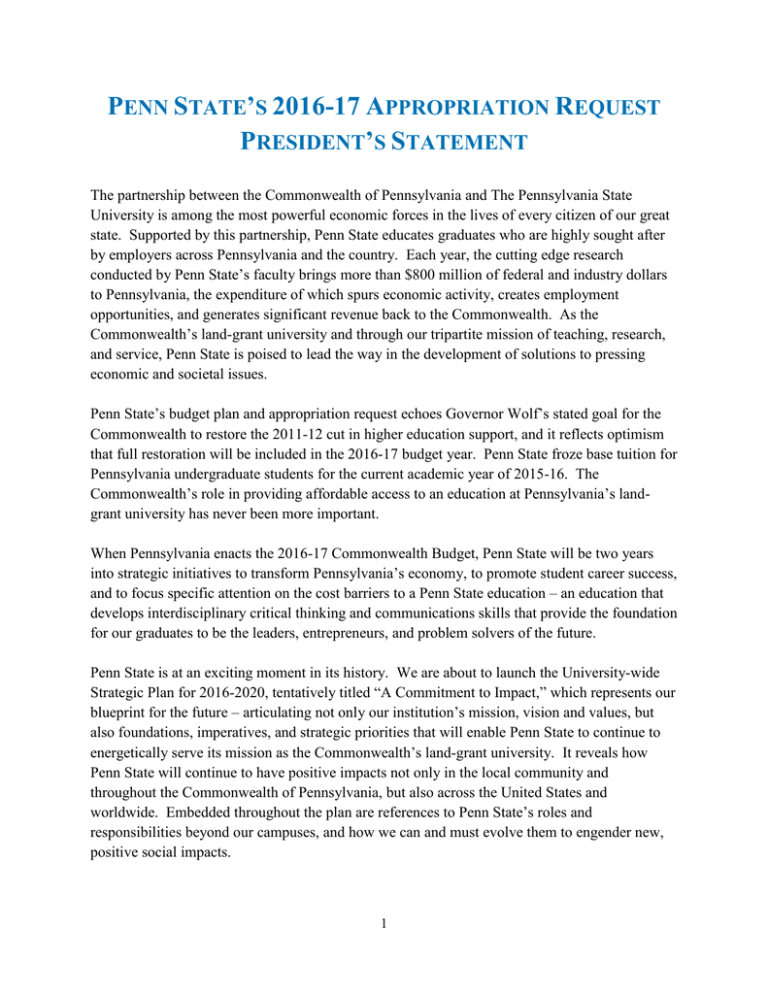
PENN STATE’S 2016-17 APPROPRIATION REQUEST PRESIDENT’S STATEMENT The partnership between the Commonwealth of Pennsylvania and The Pennsylvania State University is among the most powerful economic forces in the lives of every citizen of our great state. Supported by this partnership, Penn State educates graduates who are highly sought after by employers across Pennsylvania and the country. Each year, the cutting edge research conducted by Penn State’s faculty brings more than $800 million of federal and industry dollars to Pennsylvania, the expenditure of which spurs economic activity, creates employment opportunities, and generates significant revenue back to the Commonwealth. As the Commonwealth’s land-grant university and through our tripartite mission of teaching, research, and service, Penn State is poised to lead the way in the development of solutions to pressing economic and societal issues. Penn State’s budget plan and appropriation request echoes Governor Wolf’s stated goal for the Commonwealth to restore the 2011-12 cut in higher education support, and it reflects optimism that full restoration will be included in the 2016-17 budget year. Penn State froze base tuition for Pennsylvania undergraduate students for the current academic year of 2015-16. The Commonwealth’s role in providing affordable access to an education at Pennsylvania’s landgrant university has never been more important. When Pennsylvania enacts the 2016-17 Commonwealth Budget, Penn State will be two years into strategic initiatives to transform Pennsylvania’s economy, to promote student career success, and to focus specific attention on the cost barriers to a Penn State education – an education that develops interdisciplinary critical thinking and communications skills that provide the foundation for our graduates to be the leaders, entrepreneurs, and problem solvers of the future. Penn State is at an exciting moment in its history. We are about to launch the University-wide Strategic Plan for 2016-2020, tentatively titled “A Commitment to Impact,” which represents our blueprint for the future – articulating not only our institution’s mission, vision and values, but also foundations, imperatives, and strategic priorities that will enable Penn State to continue to energetically serve its mission as the Commonwealth’s land-grant university. It reveals how Penn State will continue to have positive impacts not only in the local community and throughout the Commonwealth of Pennsylvania, but also across the United States and worldwide. Embedded throughout the plan are references to Penn State’s roles and responsibilities beyond our campuses, and how we can and must evolve them to engender new, positive social impacts. 1 Our vision, “Penn State will be a global leader in learning, discovery, and engagement that fosters innovation, embraces diversity in all its forms, and inspires achievement that will change the world in positive and enduring ways,” is supported by six foundational principles: Enabling Access to Education, Engaging Our Students, Embracing a Diverse World, Enhancing Global Engagement, Driving Economic Development, and Endowing a Sustainable Future. Five strategic themes: - Transforming Education, Elevating the Arts and Humanities, Enhancing Health, Managing Resources, and Leveraging Digital Innovation each represent an area of substantial opportunity, as well as a breadth and depth of expertise and interest across multiple Penn State units where the University is well positioned, with strategic investment of resources, to make profound and measurable impacts. The themes intersect unit plans and draw from the human capital, infrastructure, and programs they represent. They also leverage collective energy and resources to enable previously unimaginable outcomes. We highlight below several examples of where the strategic plan is guiding our future focus, and where partnership with the Commonwealth is vital to success. JOB CREATION, ECONOMIC DEVELOPMENT, STUDENT CAREER SUCCESS In January 2015, Penn State launched “Invent Penn State,” a new $30 million initiative focused on leveraging Penn State’s research, knowledge, and entrepreneurial spirit to be a driver for job creation, economic development, and student career success. Our aim is to accelerate the transfer of new ideas into useful products and processes that encompass a broad range of fields. In addition, Penn State is developing a culture that encourages, nurtures, and rewards entrepreneurship — not just in STEM, but in the arts, health and human development, education and more. By doing that, we not only advance the success of our students and faculty, we help our business and community partners to grow along with the economy of the Commonwealth. Central to the success of this initiative is collaboration with students, faculty, and staff working with businesses, communities, and governmental partners across the Commonwealth. This will benefit the communities we serve and the innovators working among us. Working together to develop new initiatives and programs will create a powerful path to economic development, with strong local and state impact. It will also allow us to train students at the cutting edge, and place students in those emerging fields and job opportunities. Already, Penn State’s entrepreneurial ecosystem is beginning to crystalize. Penn State is putting in place the organization and people to guide and support its partners along their entrepreneurial pathways: working with students to encourage ideation, then helping them to kick-start those ideas into promising new companies; collaborating with communities and corporations; using intellectual resources; partnering with alumni to mentor students; shepherd fledgling businesses; and investing in promising, innovative startups. 2 Invent Penn State is an ambitious undertaking. Courses, and minor and major degree tracks focused on entrepreneurship are being created; new faculty members are bringing with them a heightened awareness of what is possible. It is a cultural shift — one in which discovery has a clear path to drive the economy and benefit humankind. We believe that this is what it means to be a public university that combines excellence in teaching, research and service. It also embodies our mission of ensuring access to a top-notch education and improving the quality of life for everyone in the state, and society in general. ADDRESSING THE COST BARRIERS TO A PENN STATE EDUCATION Student debt and the cost of attendance are increasing at troubling rates as a result of a variety of factors, including the substantial decline of funding for public universities in nearly every U.S. state. Two-thirds of Penn State students receive need-based financial aid and average debt has grown from $20,000 a decade ago to $35,429. In too many cases, students give up in frustration and leave school without a degree — still saddled with loan debt. This is not only a tragedy for the student, it’s a burden for society as well. Generating philanthropic support for scholarships was the primary goal of our last fundraising campaign, and it remains a core institutional priority. In addition, Penn State continues to strive for efficiencies in our operations in ways that support and advance the quality of a Penn State education. Due to large numbers of need-based students and socioeconomic challenges in communities throughout the Commonwealth, Penn State’s ability to educate all students for a life of learning and productive careers is crucial. For the current academic year, 2015-16, Penn State held base tuition flat for Pennsylvania resident undergraduate students for the first time in nearly 40 years. This action affected the cost for all Pennsylvania undergraduates regardless of their financial resources. Penn State has implemented other initiatives to address affordability for need-based students who graduate at a rate 22 percent lower than students who come from the highest income brackets, and on average, take longer to graduate often due to financial pressures. To address these realities, Penn State is investing $6 million annually in new initiatives to improve student success across the Commonwealth. This year, we’re piloting five ways to ensure our students make academic progress to graduate on time: 1) increased institutional scholarship support; 2) summer school and on-campus employment for first- and second-year students - summer school gives students a jump start in a less hectic setting and on-campus employment means less commuter time and a better understanding of student employee needs; 3) math, English and foreign language preparation for incoming students who may be struggling left unaddressed, those struggles could add time to their academic programs; 4) expansion of a 3 program to help students from other campuses transition to a new environment - with timely degree completion as the goal; and 5) increased emphasis on financial literacy and well-being. These five areas, when implemented effectively, can make major differences for our students. It can mean thousands of dollars in savings and a shorter time to degree. We’re calling this new focus Plan4 Penn State. Plan for college; plan for less debt; plan for four years. We hope that our efforts will open the door for more students to earn a Penn State education, and Penn State looks forward to working with the General Assembly to help all of the families of Pennsylvania do so, regardless of socioeconomic status. THE ENERGY UNIVERSITY Pennsylvania is the nation’s second largest natural gas producer; the fourth-largest coalproducing state; the only state producing anthracite coal; it is ranked second in the nation in electricity generation from nuclear power; and renewable energy accounted for four percent of Pennsylvania’s net electricity generation. Clearly Pennsylvania plays a critical role in our nation’s energy future. Likewise, Penn State has established itself among the very top tier of America’s energy research universities. Penn State is ranked in the top five for scholarly work in five categories: Energy Policy, Economics and Law; Fossil Fuels, Combustion, Turbo, Carbon Capture; Renewable Energy; Distribution, Efficiency, Grid, Storage, Smart Build; and Energy and the Environment. With this recognition comes responsibility - to assess and address societal needs and industry demands; to accelerate the trajectory of fundamental discovery and applied innovation; and to transform the energy sector to meet the challenges of the 21st century. With more than 320 individual investigators across 11 colleges working in energy related disciplines, Penn State is well positioned to achieve these outcomes. We will continue to invest in groundbreaking research and analysis, novel technologies, exceptional graduates, and effective partnerships that collectively turn data and knowledge into impact. AGRICULTURAL RESEARCH AND COOPERATIVE EXTENSION The 2016-17 budget plan proposes a $9.0 million increase in the state’s investment in Agricultural Research and Cooperative Extension and restores the amount to that provided by the Commonwealth in 2010-11. At least $2.9 million is needed to support inflationary operating increases for these activities for 2015-16 and 2016-17. The remaining funds would allow the College to rebuild capacity around several critical, immediate threats facing Pennsylvania agriculture including: 4 Increase research and expertise in support of the poultry industry, specifically focused on the continuing threat of highly pathogenic avian influenza. Assist farmers and food processors affected by the new, complex Food Safety Modernization Act (FSMA), which is the most far-reaching reform of food safety laws in more than 70 years and threatens the viability of agricultural businesses. FSMA will produce significant compliance pressures on Pennsylvania growers, packers, distributors, and food and feed manufacturers and will require extensive research and training to allow businesses to stay competitive and solvent. Provide for both research and education to assist agriculture in meeting EPA water quality metrics for nutrient management, as well as to help address stormwater management in Pennsylvania communities. Increase technology transfer and education focusing on precision agriculture, which is necessary to remain nationally and internationally competitive. COST CONTAINMENT AND INTERNAL REALLOCATIONS For several decades, Penn State has reallocated funds within the budget rather than pass along all of the cost increases to our students or to the citizens of the Commonwealth. Our budget plan includes funds made available in the operating budget from restructuring our post-retirement health care liability, funds set aside in anticipation of the abrupt increase in the State Employees’ Retirement System employer contribution rate, and other targeted administrative budget reallocations. CONCLUDING REMARKS Since 1855, Penn State and the General Assembly have partnered to benefit families and communities across the Commonwealth. The plans outlined in this document represent a starting point for how, together, we can have an even larger impact. We look forward to ongoing conversations with the Commonwealth about the enormous potential of increased investment in Penn State as a vehicle to advance the economic development agenda for Pennsylvania. The initiatives already underway are off to a strong start and offer a foundation upon which to leverage the Penn State-Commonwealth partnership to fuel Pennsylvania’s economy. Together, Penn State and the Commonwealth can create jobs for our students and for citizens in every corner of Pennsylvania. Working with legislators, business leaders, communities, and other partners, we are prepared to make short- and long-term investments that will benefit generations of Pennsylvanians. 5 Many factors contribute to an individual’s ability to earn a Penn State degree, and we must address all of these factors if we are to increase access, especially for populations that have historically had barriers to access. Our goal is to make the pursuit and completion of a Penn State education within reasonable reach for students with the ability and desire to attend. Finally, Penn State’s educational programs, research, and outreach will continue to make measurable and meaningful differences in the economic development of our communities, from local to global levels. Strengthened by our partnership with the Commonwealth, Penn State can drive job creation, economic development, and student career success. We will accelerate the transfer of new ideas into useful products and processes in areas such as energy, food and nutrition, environmental protection, health care, manufacturing, educational technologies, medical devices, and pharmaceuticals, among many others. Together, we can implement a bold vision for a bright future. Thank you for your support and consideration. Respectfully Submitted, Eric J. Barron, President Penn State University 6 HIGHLIGHTS OF PENN STATE’S 2016-17 BUDGET PLAN AND APPROPRIATION REQUEST APPROPRIATION REQUEST The University is requesting a total appropriation of $353.3 million. A $39.5 million increase in the Educational and General (E&G) or General Support line item. The requested increase assumes that the finalized 2015-16 appropriation will be $224.8 million, a 5.0 percent increase over 2014-15. The additional $39.5 million would fully restore the General Support appropriation to the 2010-11 level of $264.3 million (E&G). An increase in the amount of $9.0 million is requested for our programs in Agricultural Research and Cooperative Extension which will also fully restore state support to the 2010-11 level of $55.2 million. Increased support of $3.0 million is included for the Pennsylvania College of Technology to build on recent increased investments from the Commonwealth to expand instructional capacity in the technical fields most in demand by students and Pennsylvania employers. Additional State and Federal Medical Assistance funding of $1.7 million also is included for the Penn State Milton S. Hershey Medical Center. TUITION If the Commonwealth is able to provide the requested appropriation, Penn State will not increase base tuition for Pennsylvania resident undergraduate students for the second consecutive year. BASIC OPERATING COSTS Faculty and Staff Compensation – Provide a modest pool of funds for merit-based inflationary increases with a smaller pool to address targeted market and equity concerns as well as the funds necessary to fulfill contractual obligations. Benefits – Respond to the increasing employer contribution rate for the State Employees’ Retirement System (SERS) and an estimated increase in health care. Facilities – Provide for facilities cost increases, including increasing fuel and utilities costs, the maintenance and operation of new facilities, the necessary additional funding to address asset preservation of an aging physical plant, and to support the capital needs related to major renewals and replacements of facilities across our multiple locations. 7 DETAILS OF PENN STATE’S 2016-17 BUDGET PLAN AND APPROPRIATION REQUEST The University’s proposed budget plan for 2016-17 reflects Governor Wolf’s stated goal to restore funding to Pennsylvania institutions of higher education to the level appropriated prior to the major cuts in 2011-12. If the Commonwealth is able to provide this level of support, Penn State will freeze base tuition for Pennsylvania resident undergraduate students for the second consecutive year. Table 1 summarizes the proposed budget changes for the Educational and General budget (General Support), Agricultural Research and Cooperative Extension, the College of Medicine at the Milton S. Hershey Medical Center, and the Pennsylvania College of Technology. Penn State’s request for an appropriation increase of $53.2 million for 2016-17 is summarized on Table 2. Details of the University’s proposed budget plan and appropriation request are discussed below. EXPENSE CHANGES Faculty and Staff Salary Compensation : Penn State operates in an extremely competitive environment for faculty and staff. As keepers, creators, and transmitters of knowledge, the best way for us to continue to help Pennsylvania’s communities is to maintain excellence across those activities that are core to our missions. We compete with other great institutions to bring in the best talent. Dozens of our faculty are recruited by other universities every year. We strive to recruit and retain the very best faculty and staff in a fiscally responsible manner. The budget plan for 2016-17 includes $39.2 million for salary adjustments and related employee benefits. Benefits and Insurances : The University’s budget plan includes projected increases of $16.7 million for benefits cost increases. This includes increases for health care and retirement. During the previous five-year period of 2011-12 through 2015-16, increases in the total annual ongoing amount required for health care and retirement have exceeded $105.7 million. These increases had to be absorbed at the same time that the General Support appropriation, which included both E&G and Agricultural Research and Cooperative Extension in 2010-11, was cut by $60.7 million - cuts of $50.2 million to E&G and $10.5 million to Agricultural Research and Cooperative Extension. The University is also projecting an increase in property and liability insurances and the cost of external audits for 2016-17. 8 Facilities: A total of $22.0 million is projected for facilities cost increases. Included are funds for the maintenance and operation of new or newly renovated facilities, fuel and utilities increases, deferred maintenance projects, and the continuation of the University’s capital improvement program. Strategic Priorities: The 2016-17 budget plan includes funding for the most important strategic priorities of the university. Investments will be targeted in areas described in the President’s Statement: 1) Economic Development, Job Creation, Student Career Success; 2) Addressing the Cost Barriers to a Penn State Education; and 3) The Energy University. Internal Budget Reductions and Other Cost Savings Initiatives: The budget plan is targeting at least $20 million in expense reductions. This includes funds available from restructuring our post-retirement health care liability, funds set aside in prior years in anticipation of the rapid rise in the employer contribution rate for the State Employees’ Retirement System, and targeted administrative budget reductions. These reductions will be made from the recurring expense base and will lower budgeted expenses in every year going forward. Student Aid: As just one among multiple strategies to address access and affordability, our plan proposes adding $2.0 million for need-based student aid, bringing the total of permanently budgeted funds to $52.0 million. These funds will be used to leverage additional private donations for student support. AGRICULTURAL RESEARCH AND COOPERATIVE EXTENSION The College of Agricultural Sciences relies on the 150-year old land-grant partnership of federal, state, and county governments as the foundation for agricultural research and statewide extension programs. The federal, state, and county funds that support Agricultural Research and Cooperative Extension are not supplemented with student tuition. The state appropriation provides the required matching funds that allow Penn State to access Federal Agricultural Research appropriations and support from Pennsylvania’s counties for Cooperative Extension. Now more than ever, funding for the agricultural research and support for the state’s cooperative extension network is an investment that ensures that the agriculture industry will be able to continue to advance this important sector of the economy and to safeguard Pennsylvania’s natural resources. The 2016-17 budget plan proposes an additional $9.0 million in the state’s investment in Agricultural Research and Cooperative Extension. At least $2.9 million is needed to support inflationary operating increases for these activities for 2015-16 and 2016-17. 9 The remaining funds would allow the College to rebuild capacity around several critical, immediate threats facing Pennsylvania agriculture. INCOME CHANGES The University’s budget plan includes projected income increases of $79.0 million. This amount includes $23.7 million from projected tuition and fee changes. Penn State students who are Pennsylvania resident undergraduates would not see an increase in base tuition rates for the second consecutive year. The University is requesting an appropriation increase of $51.5 million (see Table 2). Of this amount, $39.5 million for Penn State’s General Support line, in combination with the expected increase yet to be approved for 2015-16, would restore the Commonwealth’s investment to the amount received in 2010-11 of $264.3 million. Also, as part of the direct appropriation, an additional $3.0 million is requested for the Pennsylvania College of Technology. An increase in the amount of $9.0 million is included for our programs in Agricultural Research and Cooperative Extension funded through the Agricultural College Land Scrip Fund, also to restore the amount to the level received in 2010-11. An additional $1.7 million is requested in the State and Federal Medical Assistance funding provided to the Milton S. Hershey Medical Center through the Pennsylvania Department of Human Services. The University is projecting an additional $2.8 million in other income primarily from increases in the facilities and administration cost recovery from grants and contracts and additional investment income. 10 Table 1 Summary of Proposed Changes 2016-17 Budget Plan and State Appropriation Request ($ in thousands) EXPENSE CHANGES: Basic Operating Costs: Salary Adjustments Benefits Insurances & Audit Facilities Educational and General Ag. Research & Coop. Ext. $35,294 12,884 750 21,101 $794 611 Strategic Priorities and Other Program Needs 8,000 Libraries, Computing and Telecommunications Internal Budget Reductions Student Aid Student Activities Student Facilities 665 (20,072) 2,000 585 580 TOTAL EXPENSE CHANGES College of Medicine PA College of Technology $1,310 529 $1,753 2,639 300 629 $39,151 16,663 750 22,030 629 16,218 7,589 $61,787 410 $8,994 Total 1,075 (20,072) 2,000 585 580 $2,549 $5,650 $78,980 $750 1,799 $2,671 $23,691 2,799 1,000 2,979 51,490 $5,650 $78,980 INCOME CHANGES: Tuition & Fees Other Income College of Medicine Transfer # Requested Appropriation Increase TOTAL INCOME CHANGES $20,270 1,000 1,000 39,517 8,994 $61,787 $8,994 $2,549 * The University is also requesting an additional increase of $1,737,000 in the State and Federal Medical Assistance funding provided to the Milton S. Hershey Medical Center through the Pennsylvania Department of Human Services. Penn State's overall request for additional Commonwealth support for 2016-17 totals $53,227,000. 11 Table 2 2016-17 Appropriation Request ($ in thousands) 2015-16 Anticipated Appropriation Direct State Appropriation: General Support* Pennsylvania College of Technology Total Direct State Appropriation Agricultural College Land Scrip Funds: Projected Increases 2016-17 Requested Appropriation $224,816 $39,517 $264,333 17,584 2,979 20,563 242,400 42,496 284,896 46,237 8,994 55,231 11,399 1,737 13,136 $300,036 $53,227 $353,263 Department of Human Services: M.S. Hershey Medical Center Medical Assistance Funding (estimate) TOTAL APPROPRIATION *The 2015-16 anticipated appropriation assumes 5.0 percent increase over 2014-15. 12

